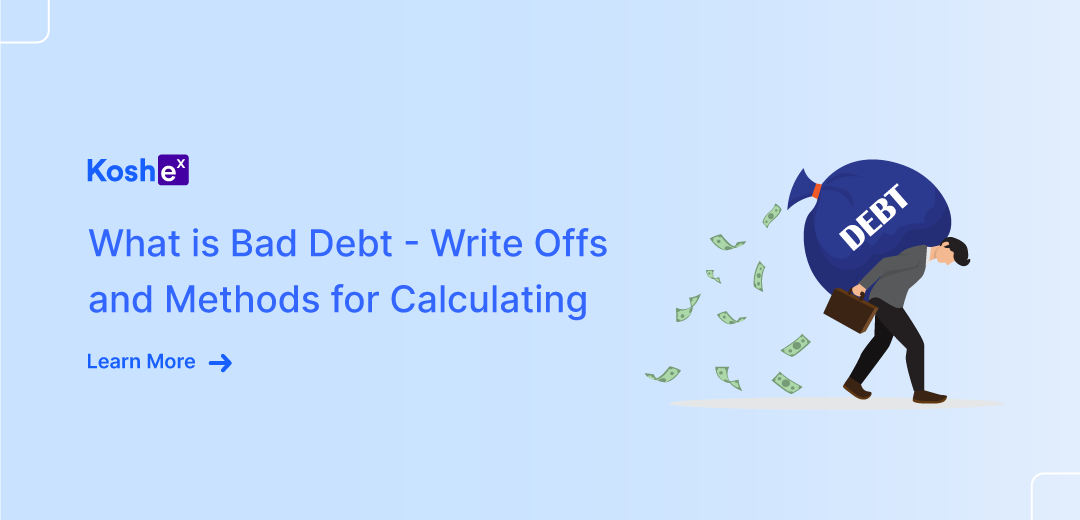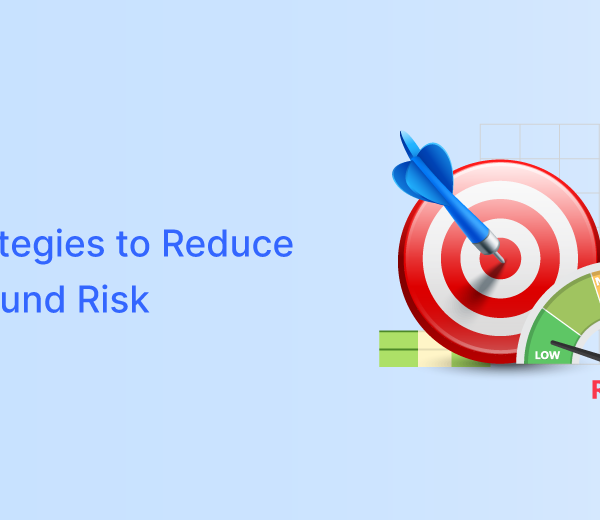In the world of finance and accounting, the term bad debt is a crucial concept that businesses, financial institutions, and even individuals need to be familiar with. The term bad debt may make you wonder if there is something called good debt.
To answer the question, yes, there are good debts. If you’ve got receivables that will be repaid at an agreed-upon time, possibly with interest, it’s called a good debt. However, bad debt is money that is owed to the company but is unlikely to be paid.
In this blog, we will be talking about the definition of bad debt, the concept of write-offs, the methods for calculating bad debt, and the importance of debt management.
What Is Bad Debt?
A bad debt is an amount of money owed to a creditor that cannot be collected due to various reasons, such as the borrower’s financial difficulties, insolvency, or refusal to pay. When a debt is deemed uncollectible, it is written off as a loss on the company’s financial statements, affecting profitability.
What Are The Types Of Bad Debt?
In accounting, bad debt can be categorised into two primary types:
Consumer Bad Debt
This type of bad debt occurs when individuals, typically consumers, fail to repay their debts. It often stems from personal loans, credit cards, or other forms of borrowing. Consumer bad debt is more common among individuals facing financial hardships, like a job loss or unexpected expenses, which could make it challenging to meet their financial obligations.
Commercial Bad Debt
Commercial bad debt pertains to debts owned by businesses to other businesses. It occurs when a company fails to pay invoices, bills or loans to its suppliers, creditors, or financial institutions. Commercial bad debt can result from a company’s insolvency, mismanagement of finances, or economic downturns affecting the business’s ability to meet its financial commitments.
What Is A Write-Off?
A write-off is a reduction of the recognised value of something. In accounting terminology, a write-off refers to reducing the value of an asset while debiting to a liabilities account. The general scenarios for business write-offs include unpaid bank loans, losses on stored inventory, and unpaid receivables.
Here is a detailed description of each of these cases:
Unpaid Bank Loans – Banks and other financial institutions use the write-off method when all the collection methods are exhausted. A bank’s loan loss reserves, a non-cash account that manages expectations for losses and unpaid loans, can give a deep insight into the write-offs. While loan loss reserves project unpaid loans, write-offs work as the final account taken on them.
Stored Inventory Losses – A company may have to write off some of its inventory for several reasons, such as stolen, lost, spoiled, or obsolete. Writing off inventory on a balance sheet involves an expense debit for the value of unusable inventory and a credit to inventory.
Unpaid Receivables – When a business is convinced that a customer is not going to pay the bill, the business may have to write it off. On the balance sheet, the debit to an unpaid receivables account may have to be marked as a liability and a credit to accounts receivable.
What Are The Methods To Calculate Bad Debt?
To handle bad debts effectively, businesses and financial institutions need robust methods to estimate and account for uncollectible accounts. The most common methods for calculating bad debts are the Direct Write-Off Method and the Allowance Method.
- Direct Write-Off Method
In this technique, the bad debt is directly considered as an expense, and the debt ratio is calculated by dividing the uncollectible amount by the total accounts receivables for that year.
Here’s how this method works:
- Identify which customer accounts are uncollectible.
- Directly remove the uncollectible amount from accounts receivable.
- Record it as a bad debt expense.
Example – A company sells products worth ₹5 lakhs on credit. After repeated attempts to collect the amount, they decide to write it off as bad debt. Under the direct write-off method, they would debit ₹5 lakhs as a bad debt expense and credit the same to accounts receivable.
The drawbacks of the method are:
- Even though this is an easy method for bad debt calculation, it is not very accurate. It can only be applied when there is a confirmation that an invoice won’t be paid for, which takes a lot of time.
- This method is also inconsistent with the matching principle of accounting, which dictates that expenses should be matched with the revenue they help generate.
- Allowance Method
The allowance method is used to manage bad debt in businesses that rely heavily on credit sales. This approach involves estimating bad debts in advance, often based on past experiences, and creating an allowance or reserve for potential bad debts. It allows for a more consistent reflection of a company’s financial condition.
To calculate bad debt using the allowance method, there are two distinct approaches:
a. Percentage Of Bad Debt
The first method involves deterring the bad debt rate by analysing historical data. This rate is calculated by dividing the total bad debt by either the total credit sales or the total accounts receivable.
% of Bad Debt = Total Bad Debts / Total Credit Sales (or Total Accounts Receivable)
Once the bad debt rate is determined, it is applied to the current credit sales.
For example, if the bad debt rate is 1%, 1% of the current credit sales would be allocated to the bad debt allowance account.
b. Account Receivable Aging Method
Another method for estimating bad debt is through the utilisation of the account receivable aging technique. This approach relies on an aging report that is classified based on age, such as those overdue by 0 to 30 days, 31 to 60 days, 61 to 90 days, and so forth. It is crucial to assign specific percentages of bad debt to each aging category.
Generally, the longer an invoice remains unpaid, the lower the likelihood of it being settled. For instance, a 1% bad debt allocation could be assigned to invoices overdue by 0 to 30 days, while a higher percentage, such as 30%, might be assigned to invoices that are past 90 days.
To calculate the projected bad debt using the account receivable aging method, you need to figure out the total amount of accounts receivable in each aging category and apply the corresponding bad debt percentages. By summing up these amounts, you can determine the overall total of anticipated bad debts, which can then be allocated to the allowance account.
The below table shows how a company would use the accounts receivable aging method to estimate bad debts.
| Age of Receivable | <30 days | 30 to 60 days | 61 to 90 days | 91+ days |
| % Not Collected | 1% | 4% | 10% | 30% |
| Total Receivables | ₹10,000 | ₹2,000 | ₹5,000 | ₹3,000 |
| Estimation of Uncollected Amount | ₹100 | ₹80 | ₹500 | ₹900 |
| Total Bad Debts | ₹1,580 | |||
How To Manage Bad Debt?
Managing bad debt is important for the long-term financial health of any business. Here are some ways in which debts can be managed.
Assess credibility – Lenders should thoroughly analyse the creditworthiness of borrowers before giving out credit. This can include assessing their credibility, verifying income and employment, and reviewing payment histories.
Set clear payment terms – Lenders should communicate payment terms to borrowers, including due dates, interest rates, and any penalties for late payments. Borrowers should also be aware of the consequences of defaulting on their debts.
Monitor accounts closely – Lenders should monitor borrower accounts regularly to identify any signs of financial distress, like missed payments or high debt-to-income ratios. Early intervention can help prevent bad debt from becoming unmanageable.
Offer payment plans – Lenders may be able to work with borrowers to develop payment plans that allow them to repay their debts in manageable instalments.
Seek legal action – Lenders may take legal action against borrowers who fail to repay their debts. This can include filing lawsuits or seeking court judgements. It is important to ask for legal advice before taking this step.
Improve financial management – Borrowers can take steps to improve their financial management, like creating budgets, reducing expenses, and increasing income.
Bad Debt, Write-Offs & Calculation – The Conclusion
Bad debt is an unavoidable part of doing business and it exists in small businesses, large corporations, and financial institutions. While it can negatively impact profitability and cash flow, implementing strong systems to manage and calculate bad debt can minimise its effects. Understanding bad debts and the write-off process, along with using appropriate methods such as the direct write-off or allowance method, can make sure that businesses maintain financial health and transparency.
Effective management of bad debt is essential for financial sustainability and will help companies maintain more accurate financial statements, leading to better decision-making. In the end, while bad debts can’t always be avoided, they can certainly be minimised with the right approach.
Frequently Asked Questions (FAQs)
How do financial institutions calculate bad debt?
Banks and financial institutions use complex risk models and provisioning norms set by regulators, like the Reserve Bank of India (RBI), to calculate bad debt and determine how much to set aside for potential losses.
How frequently should businesses review their bad debts?
Businesses should periodically review their accounts receivable and bad debts, typically on a quarterly or annual basis. Regular reviews ensure that bad debts are identified early and written off in a timely manner.
Can bed debt be recovered after being written off?
In some cases, bad debt may still be recovered even after it has been written off. If the debt is recovered, the amount is typically recorded as income in the financial statements for the period.









Leave a Comment